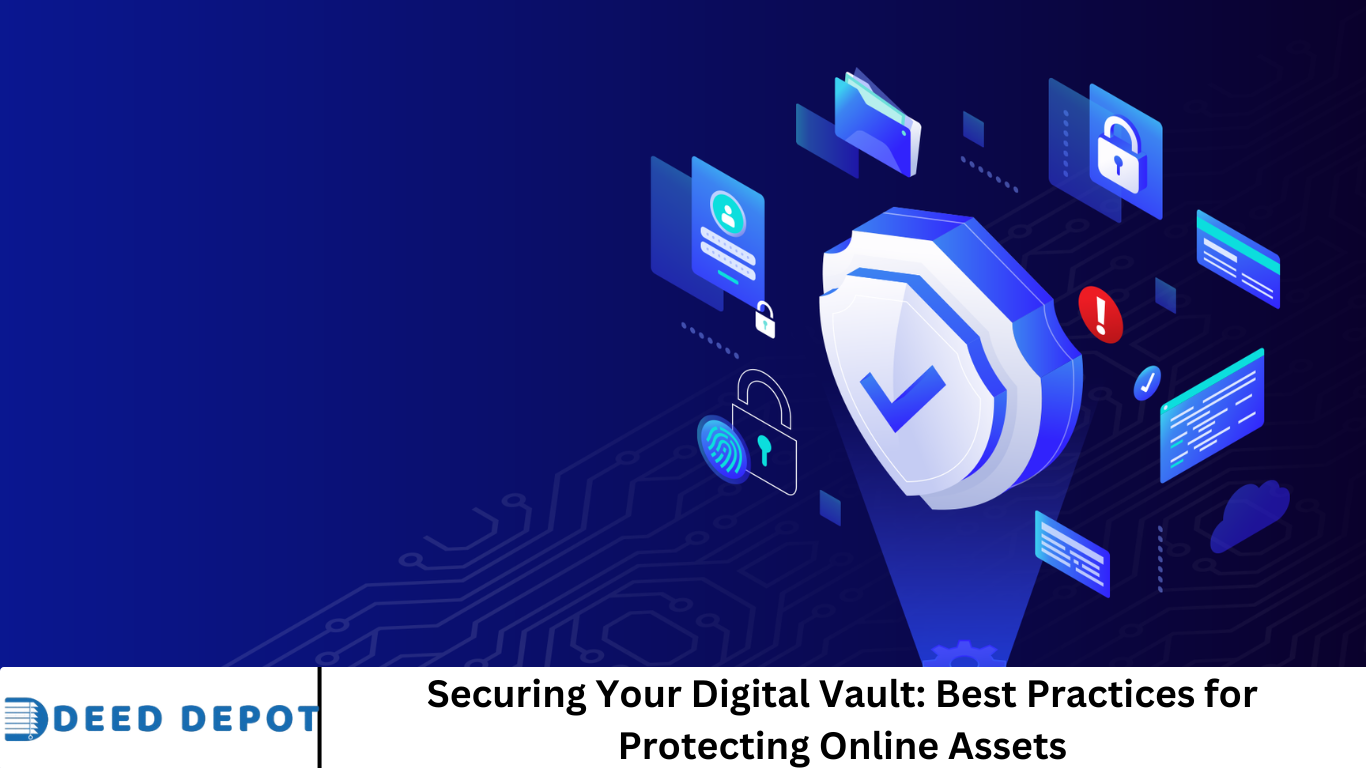In an increasingly digital world, securing your online assets is no longer optional—it’s a necessity. From financial records and intellectual property to customer data and creative content, digital assets are the lifeblood of businesses and individuals alike. But as the value of these assets grows, so does the threat of cyberattacks, data breaches, and theft.
This comprehensive guide explores best practices for protecting your digital vault, helping you understand why digital asset security is critical, how to implement it effectively, and what tools and strategies can help you stay one step ahead of threats.
More Read: Understanding Digital Vaults: A Simple Guide for Beginners
What Are Digital Assets?
Digital assets are any content or data that is stored digitally and holds value. Common examples include:
- Financial documents
- Customer databases
- Login credentials
- Cryptocurrency and NFTs
- Intellectual property (e.g., patents, trademarks)
- Digital media files (videos, photos, designs)
- Software and source code
Whether personal or professional, these assets require robust protection to prevent unauthorized access, data loss, or corruption.
Why Securing Digital Assets Matters
The consequences of unsecured digital assets can be severe:
- Financial loss: Hackers can steal funds, intellectual property, or sensitive business data.
- Reputational damage: A data breach can erode trust with customers and partners.
- Legal and regulatory risks: Violating data protection laws (like GDPR, HIPAA, or CCPA) can lead to heavy fines and legal consequences.
- Operational disruption: Malware and ransomware can halt operations for days or even weeks.
As cyber threats continue to evolve, adopting a proactive security strategy is vital for protecting your digital vault.
1. Use Strong, Unique Passwords
Passwords are often the first line of defense against unauthorized access.
Best Practices:
- Use long, complex passwords with a mix of uppercase letters, lowercase letters, numbers, and special characters.
- Never reuse passwords across different platforms.
- Consider using a reputable password manager to store and generate unique passwords securely.
Pro tip: Avoid storing passwords in plain text documents or email drafts.
2. Enable Two-Factor Authentication (2FA)
Two-factor authentication (2FA) adds an extra layer of security beyond just a password. It typically requires a second form of verification, such as:
- A one-time code sent via SMS or email
- An authentication app like Google Authenticator or Authy
- Biometric verification (e.g., fingerprint or facial recognition)
2FA dramatically reduces the risk of unauthorized access, even if your password is compromised.
3. Implement Role-Based Access Controls (RBAC)
For businesses or organizations managing digital assets:
- Not everyone needs access to everything.
- Implement role-based access controls to limit access to only what’s necessary for a user’s role.
This minimizes internal risks and makes it easier to track data usage and potential breaches.
4. Regularly Back Up Your Data
Backing up your data ensures that you can recover it in the event of:
- Cyberattacks
- System failures
- Accidental deletions
- Natural disasters
Best Practices:
- Follow the 3-2-1 rule: Keep three copies of your data, on two different types of media, with one stored offsite.
- Automate backups to reduce human error.
- Test your backups regularly to ensure they work.
5. Use Encryption
Encryption transforms your data into unreadable code unless the correct decryption key is used.
- At-rest encryption: Protects data stored on devices or servers.
- In-transit encryption: Secures data as it moves over networks (e.g., HTTPS, VPNs).
Use end-to-end encryption for sensitive communications and consider full disk encryption on laptops and mobile devices.
6. Deploy a Digital Asset Management (DAM) System
A Digital Asset Management (DAM) platform helps you organize, store, and secure digital content efficiently.
Key Features to Look For:
- Access control and permissions
- Audit trails for tracking user activity
- Cloud storage with encryption
- Automatic backups and versioning
- Integration with other platforms (e.g., CMS, CRM)
DAM tools streamline digital asset workflows while enhancing security and compliance.
7. Monitor and Audit System Activity
Constant vigilance is crucial. Set up real-time monitoring and alerts for:
- Unusual login attempts
- Changes to critical files
- High-volume downloads
- Unauthorized access
Use audit logs to maintain a record of user activity. This not only deters insider threats but also supports forensic investigations if needed.
8. Keep Software and Systems Updated
Outdated software is a major vulnerability. Hackers often exploit known flaws in older versions.
Best Practices:
- Enable automatic updates for operating systems, apps, plugins, and firmware.
- Regularly update antivirus and anti-malware software.
- Monitor vendor announcements for zero-day vulnerabilities and patches.
9. Educate and Train Users
Human error is one of the biggest security risks. Regular training can help users recognize threats and follow best practices.
Training Topics:
- Phishing and social engineering
- Password management
- Secure file sharing
- Identifying suspicious links or downloads
Hold periodic refresher courses and send out phishing simulations to test awareness.
10. Use Secure File Sharing Methods
Avoid sending sensitive data via unsecured channels like email or basic cloud links.
Instead, use:
- Encrypted file transfer services
- Password-protected downloads
- Expiring links with download limits
Ensure only authorized users can access shared files and monitor usage.
11. Segment Your Network
Network segmentation limits the impact of a breach by dividing your digital environment into smaller, isolated segments.
- Separate your public-facing applications from sensitive data.
- Use firewalls and intrusion detection systems (IDS) to monitor traffic between segments.
This technique enhances security by making lateral movement within your network more difficult for attackers.
12. Develop an Incident Response Plan
Despite best efforts, breaches can still occur. An incident response plan ensures you’re prepared to react quickly and effectively.
Your plan should include:
- Who to contact (internally and externally)
- Steps to contain and assess damage
- Communication protocols
- Recovery and reporting processes
Run periodic incident response drills to test readiness.
13. Leverage Blockchain for High-Value Assets
For extremely sensitive digital assets like cryptocurrency or digital contracts, blockchain technology can provide enhanced security and traceability.
Benefits of blockchain for asset security:
- Immutable records
- Decentralized storage
- Smart contract automation
- Built-in encryption and verification
It’s especially useful for managing ownership and transfers in industries like finance, art, and real estate.
14. Stay Informed on Emerging Threats
Cybersecurity is a fast-moving field. Stay current by:
- Following cybersecurity news and blogs
- Subscribing to threat intelligence reports
- Joining industry forums and communities
Awareness of new attack methods helps you adapt your security posture proactively.
Frequently Asked Question
What is a digital vault, and why do I need one?
A digital vault is a secure, encrypted storage system for sensitive digital assets such as passwords, documents, financial records, and media files. You need one to protect your data from unauthorized access, theft, or loss due to cyberattacks, system failures, or human error.
What types of digital assets should I store in a digital vault?
You should store any sensitive or valuable digital information, including:
- Login credentials and passwords
- Personal identification documents
- Financial records (bank statements, tax files)
- Intellectual property
- Contracts and legal documents
- Backup files for websites, apps, and software
- Cryptocurrency keys and NFTs
How do I choose a secure digital vault or digital asset management tool?
Look for tools with the following features:
- End-to-end encryption
- Multi-factor authentication (MFA)
- Role-based access control
- Audit logs and activity tracking
- Regular backups and version control
- Cloud security certifications (e.g., SOC 2, ISO 27001)
What are the most important best practices for protecting online assets?
Key best practices include:
- Using strong, unique passwords and a password manager
- Enabling two-factor authentication
- Regularly backing up and encrypting data
- Restricting access with role-based permissions
- Monitoring for suspicious activity
- Keeping all software up to date
How often should I update my digital security settings?
You should:
- Review access permissions monthly
- Rotate passwords every 3–6 months
- Update software and security tools as soon as updates are available
- Perform security audits quarterly or bi-annually
What should I do if I suspect my digital vault has been compromised?
Immediately:
- Change all passwords and revoke unauthorized access
- Enable MFA if it isn’t already
- Restore from a clean backup
- Review audit logs to assess the extent of the breach
- Contact your IT or security team and report the incident if needed
Can digital vaults be used for teams and businesses, not just individuals?
Yes, many digital vaults and Digital Asset Management (DAM) systems are designed for team or enterprise use. They allow for secure sharing, user role management, version control, and activity tracking across departments or organizations.
Conclusion
Protecting your digital assets requires a multi-layered, proactive approach. From strong passwords and 2FA to encryption, access controls, and employee training, every layer adds resilience to your digital vault. By implementing these best practices and staying vigilant, you not only protect what you’ve built but also gain peace of mind in an unpredictable digital landscape.


